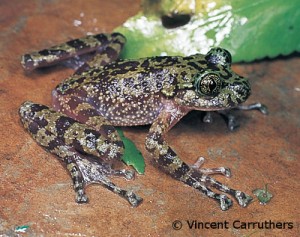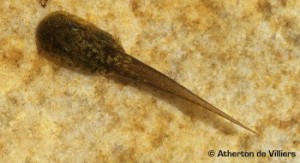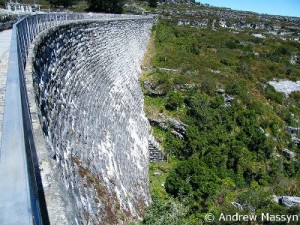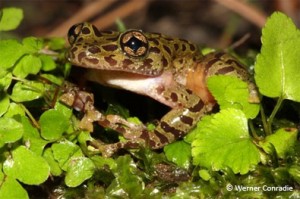
The Table Mountain ghost frog (or Rose’s ghost frog – Heleophrynidae rosei) is a focal EDGE amphibian, and is named so because it is only found on Table Mountain in Cape Town, occupying an area of only 7-8 km sq. The ‘ghost’ part of their common name might have come about due to their occurrence in the Skeleton gorge hiking trail on Table Mountain’s eastern slopes. The closest ancestors of Rose’s ghost frog are the most ancient members of the suborder Neobatrachia, which contain all the modern frogs and toads.
They diverged from their closest ancestors over 160 million years ago, and now the Heleophrynidae family of ghost frogs have only six species that exist today. Adult Table Mountain ghost frogs have strikingly coloured skins of pale green with purple or red blotches. The Table Mountain ghost frog has a flat, compressible body that enables it to hide in narrow rock crevices during the day when it is inactive. The ghost frogs inhabit mountain streams within their distribution, and have morphological adaptation suited to surviving on the rocks around these streams. As adults are frequently also found in caves, they have been called a ‘trogloxene’ species, as it is assumed that they use caves for part of their lifecycle.
Ghost frogs have highly webbed feet as an adaptation for strong swimming, but strangely, out of the water they are unable to jump very well. Table Mountain ghost frogs have unusually large suckers on their toes that help them to cling onto rocks. When sexually mature, both males and females develop spines on their bodies that lock them together during mating. Their tadpoles possess sucker-like mouthparts, which are used to feed on algae and allow them to grip on hard surfaces in fast flowing streams, also using their mouths to climb up out of streams at night.

The Table Mountain ghost frog must have a year-round water supply to support the long development of tadpoles. Ghost frog individuals have only been recorded in wet fynbos areas with rainfall of about 600mm/year, and at altitudes of 240-1,060 metres above sea level. Unfortunately, Rose’s ghost frogs are elusive and appear to be declining: it is estimated that the number of tadpoles in Skeleton Gorge has decreased by 50% since 1980.

The Table Mountain ghost frog is listed as Critically Endangered in the IUCN Red List. The range of the ghost frog is so small that factors like disease or invasive species make them particularly vulnerable. The main threats to the Table Mountain ghost frog are the spread of alien vegetation, frequent fires, and the construction of dams on the mountain, which stop water flow into the streams where they live. One of the most deadly fungal diseases in amphibians, chytridiomycosis, has been found in some populations of the ghost frog in recent years, and as these frogs have already become locally extinct in some areas of Table Mountain, this could be a death knoll for the rest.
The maintenance of the ghost frogs’ remaining breeding and non-breeding habitat is essential, such as creating native vegetation buffer zones to increase habitat quality. As with many other EDGE species, there is also a need for survey work to search for any more frogs and monitoring current populations and disease outbreaks. Moving individual Table Mountain ghost frogs may help them recover in other areas, and possibly a captive breeding programme can supplement these efforts.

In 2009 we appointed a Fellow called Werner Conradie, a herpetologist from South Africa, whose aim was to focus on conserving of threatened EDGE ghost frogs (of which there is more than one!). If you want to find out more, read his blogs about the work he is doing, and don’t forget to subscribe to the newsletter here to get all the latest EDGE updates directly to your inbox!